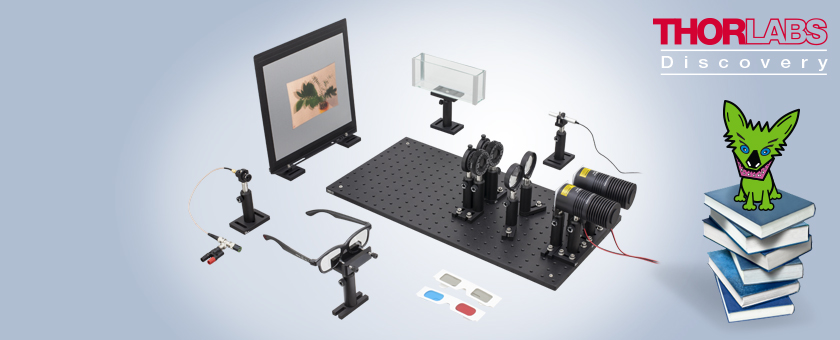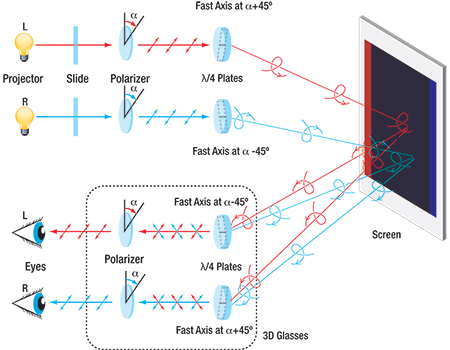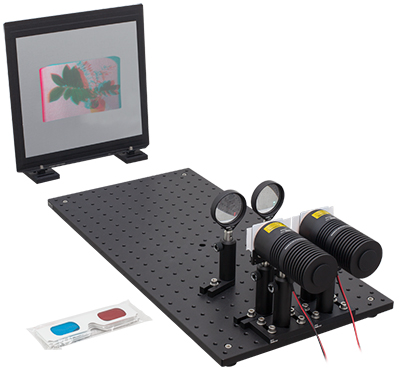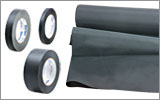Polarization and 3D Cinema Technology Kit

- Designed for Education, Demonstration, and Classroom Use
- Easy-to-Use Kits Include Components Plus Free Educational Materials

Please Wait

Click to Enlarge
Figure 1.1 The Polarization and 3D Cinema Technology Kit allows students to build their own 3D projector. The version shown here uses circular polarization and a pair of RealD 3D glasses to produce the 3D effect.
Polarization and 3D Cinema Technology Kit
- Designed for Educational, Demonstration, and Classroom Use
- Complete Photonics Kit Includes All Hardware Except Voltmeter Plus Extensive Manual and Teaching Materials
- Easy to Assemble and Use
- Choose from Educational Kits Containing Imperial or Metric Components
Experiment
- Learn how to Generate and Measure Linear and Circular Polarizations of Light
- Create a 3D Projection using Circularly Polarized Light Based on RealD™ Cinema Technology
- Additional Experiments with Red-Cyan Anaglyph 3D Images and 3D Projection Using Linear Polarization
- Measure the Rotation of the Polarization Angle of Light Passing through Optically Active Media
Thorlabs' Polarization and 3D Cinema Technology Kit includes several experiments to help students explore the concept of polarization and some of its common uses. This educational lab kit contains components to build three setups for viewing 3D images, including RealD 3D glasses and a piece of real cinema screen. Additional experiments explore some uses of polarization in industry, including determining the concentration of sugar dissolved in a liquid and mapping mechanical stress in materials.
Although some of the experiments require the use of a voltmeter, we have not included one in this educational kit since many physics labs are already stocked with them. For customers who would like to purchase a voltmeter to use with the kit, Thorlabs has a digital multimeter available here.
Thorlabs Educational Products
Thorlabs' line of educational products aims to promote physics, optics, and photonics by covering many classic experiments, as well as emerging fields of research. Each educational kit includes all the necessary components and a manual that contains both detailed setup instructions and extensive teaching materials. These lab kits are being offered at the price of the included components, with the
educational materials offered for free. Technical support from our educational team is available both before and after purchase.
Purchasing Note: English and German language manuals/teaching information are available for this product. The imperial educational kit contains the English manual and US-style power cord. The appropriate manual and power cord will be included in the metric kit based on your shipping location. The power supplies and other electronic devices in both the metric and the imperial kit accept voltages of 230 VAC and 120 VAC. Some power supplies include a switch for selecting the mains voltage. See the respective manuals for details. Please contact Tech Support if you need a different language or cord style. As with all products on our website, taxes are not included in the price shown below.

Click to Enlarge
Figure 2.1 A schematic diagram of the RealD™ 3D technology. The light from the first slide is linearly polarized via a polarizer and then circularly polarized by passing through quarter-wave plate. After the light is reflected from the screen, the RealD glasses, each consisting of a quarter-wave plate and a polarizer, allow only the passage of the left circularly polarized light to one eye and the right circularly polarized light to the other.
Polarization Experiments
The Polarization and 3D Cinema Technology Kit includes components and instructions for building three 3D projection setups. The theory and tools to construct three other experiments that study the interaction of polarized light with optical elements such as wave plates and polarizers are also provided. Experiments include:
- Measuring the Light Transmission Through Polarizers to Understand Malus' Law
- Measuring the Polarization State of a Laser
- Measuring the Sugar Concentation in a Beverage via Polarization Rotation
- Examining Stress-Induced Birefringence
- Examining the Properties of RealD™ 3D Glasses
- Setting Up 3D Projections Using Three Methods
- Red-Cyan Anaglyph Images
- Linearly Polarized Light
- RealD Method (Circularly Polarized Light)
Details of some of these experiments can be found below and a complete list of included activities is available on the Exercise List tab.
Polarization is a fundamental property of light. Understanding the generation and measurement of polarization and its possible applications is a standard topic in high school and university physics classes. This kit provides several experiments based on real-world uses of polarization to explore fundamental concepts. In the saccharimetry experiment, students can measure how the angle of rotation of linearly polarized light is affected by an optically active sugar solution and use this knowledge to determine the sugar content of soft drinks.
The kit also examines the technology that has been developed to produce stereoscopic images and 3D movies, including red-cyan anaglyph images, linear polarization, and circularly polarized light. Mounted slides, several types of 3D glasses, and a piece of real cinema screen are provided so that students can build their own 3D projection setup.
3D Cinema Technology
All stereoscopic projection methods are based on the same principle: the observed 3D image is actually composed of two images of the same object which are recorded from slightly different angles. Due to the spacing between our eyes, our right eye will naturally perceive an object from a different angle than our left eye. Our brains use this information to percieve depth in the world around us. 3D imaging techniques reproduce this effect by allowing each of the observer's eyes to view only one of two offset projected images. This can be achieved by using a pair of glasses with filters in place of lenses to block the left image from reaching the right eye and vice versa.

Click to Enlarge
Figure 2.2 A 3D anaglyph image can viewed on the screen using colored filters and red-cyan glasses. The kit includes components for several 3D projection methods, including linear polarizer glasses and the RealD™ 3D glasses commonly found in movie theaters.
Common techniques for producing 3D images include using a pair of color filters or filters that rely on the polarization state of the incident light (either linear or circular polarizations). Anaglyph images use two colors (often red and cyan) to produce a 3D effect, but distort the colors of the 3D scene. The use of orthogonal linear polarization states for each projected image avoids the problem of color distortion. However, if the viewer tilts their head, the polarizers in the 3D glasses will become misaligned with the polarization states of the two projected images, causing the viewer to see a double image.
Today, 3D projection that uses circular polarization is found in many movie theaters in the form of the licensed RealD™ technology. Advantages of this method include the ability to produce true-color 3D images that are not susceptible to ghost images or other visual artifacts.
Thorlabs' 3D Cinema Experiment
Thorlabs' Polarization and 3D Cinema Kit allows students to build 3D projectors that use each of the techniques mentioned above. First, students are introduced to the concepts of stereoscopic vision, the underlying principles of polarized light, and how each of the three 3D projection techniques works. To prepare students to apply the polarization-based 3D projection methods, a set of basic experiments on linear and circular polarization can be performed using the laser light source, polarizers, quarter-wave plates, and the three types of 3D glasses included with the kit.
Afterwards, they can use the kit to construct their own 3D projector. Advantages and disadvantages of each method can be worked out and experienced experimentally. In addition to red-cyan, linear polarizer, and RealD™ 3D glasses, a piece of silver-coated cinema screen allows students to produce high-quality 3D images.
Additional 3D Images can be downloaded from the 3D Image Gallery tab. The images can either be printed professionally at a specialty photo store or with any normal printer on transparencies (at a slightly lower quality). If you or your class have 3D images that you would like to share, submit your photos to us at techsupport@thorlabs.com and we'll consider them for addition to the image gallery.

Click to Enlarge
Figure 2.3 Students can build their own saccharimeter to determine the sugar concentration in popular soft drinks using a laser diode, polarizers, and photodetector.
Saccharimetry Experiment
When linearly polarized light is transmitted through an optically active sugar solution, the polarization vector is rotated by an angle that depends on the sugar concentration of the solution. Different types of sugars will also produce different characteristic angles of rotation. With the saccharimeter experiment included in this kit, students can measure the characteristic angle of rotation for cane sugar (sucrose) and use the results of their measurement to determine the sugar concentration of soft drinks.
Polarization and 3D Cinema Technology Kit Components

Thorlabs' Polarization and 3D Cinema Technology Kits are available in imperial and metric versions. In cases where the metric and imperial kits contain parts with different item numbers, metric part numbers and measurements are indicated by parentheses unless otherwise noted.
| Item # | Description | Qty. |
|---|---|---|
| 3D Cinema Accessories | ||
| - | Cinema Screen | 1 |
| - | Red-Cyan Glasses | 5 |
| - | Linear Polarizer 3D Glasses | 4 |
| - | RealD™ Glasses | 4 |
| Lamp Assemblies | ||
| QTH10 (QTH10/M) | Quartz Tungsten-Halogen Lamp | 2 |
| - | Halogen Bulbs, 16 W, 230 lumen | 2 |
| HSLT2 | Passive-Heat-Sink SM1 Lens Tube with External SM2 Threads | 2 |
| SM1CP2 | Externally SM1-Threaded End Cap | 2 |
| Optics and Mounts | ||
| - | LPVISE2X2 Linear Polarizer (Laser Cut into 3 Ø1" Circles) | 1 |
| RSP1D (RSP1D/M) | Ø1" Rotating Polarizer Mount | 2 |
| SM1RR | SM1-Threaded Retaining Ring | 2 |
| - | Ø1" Quarter-Wave Plate | 2 |
| LM1-A | Nested Ø1" Inner Lens Carriage | 2 |
| LM1-B (LM1-B/M) | Nested Ø1" Lens Mount Outer Ring | 2 |
| LB1630 | N-BK7 Bi-Convex Lens, Ø2", f = 100.0 mm, Uncoated | 2 |
| LMR2 (LMR2/M) | Lens Mount for Ø2" Optics | 2 |
| - | Pair of Slides for 3D Projection | 2 |
| FH2 | Filter Holder for 2" Square Filters | 2 |
| FP02 | Wide Plate Holder | 1 |
| LPVISE2X2 | 2" x 2" Linear Polarizer Sheet | 1 |
| Other Accessories | ||
| - | Glass Basin | 1 |
| - | Self-Adhesive Ruler | 1 |
| SPW606 | SM1 Spanner Wrench, Length = 1" | 1 |
| Item # | Description | Qty. |
|---|---|---|
| Laser and Mount | ||
| CPS532-C2 | 532 nm Laser Diode Module, Class 2 | 1 |
| DS5 | 5 VDC Power Supply with USB Type-A Port | 1 |
| CPSA | USB 2.0 to 2.5 mm Phono Cable | 1 |
| VC1 (VC1/M) | Small V-Clamp | 1 |
| Photodetector Assembly | ||
| SM05PD1A | Silicon Photodiode, 350 - 1100 nm, Cathode Grounded | 1 |
| SM05M10 | 1" Long SM05 Lens Tube | 1 |
| SM05RC (SM05RC/M) |
Ø1/2" Slim Slip Ring for SM05 Lens Tubes, 8-32 (M4) Tapped Hole |
1 |
| CA2812 | 12" Long SMA Coaxial Cable, SMA Male to BNC Female | 1 |
| T1452 | BNC Female to Binding Post | 1 |
| T3285 | BNC Adapter - T Adapter (F-M-F) | 1 |
| FT502 | 5 kΩ Fixed Stub-Style BNC Terminator | 1 |
| SM05D5 | Lever-Actuated Iris Diaphragm (Ø0.7 mm - Ø0.5 mm) | 1 |
| Mounting | ||
| MB1224 (MB3060/M) | Aluminum Breadboard, 12" x 24" (30 cm x 60 cm) | 1 |
| RDF1 | 4 Rubber Breadboard Feet | 1 |
| BA2 (BA2/M) | Mounting Base, 2" x 3" x 3/8" (50 mm x 75 mm x 10 mm) | 8 |
| BA1S (BA1S/M) | Mounting Base, 1" x 2.3" x 3/8" (25 mm x 25 mm x 10 mm) | 6 |
| BA1 (BA1/M) | Mounting Base, 1" x 3" x 3/8" (25 mm x 75 mm x 10 mm) | 1 |
| TR3 (TR75/M) | Ø1/2" (Ø12.7 mm) Mounting Post, 3" (75 mm) Long | 14 |
| PH3 (PH75/M) | Ø1/2" (Ø12.7 mm) Post Holder, 3" (75 mm) Long | 12 |
| UPH3 (UPH75/M) | Ø1/2" (Ø12.7 mm) Post Holder, 3" (75 mm) Long | 2 |
| AM4T (AM4T/M) | 4° Angle Block | 2 |
Imperial Kit: Included Hardware and Screws
| Item # | Description | Qty. |
|---|---|---|
| BD-3/16L | 3/16" Balldriver for 1/4"-20 Cap Screwsa | 1 |
| - | 9/64" Hex Keya | 1 |
| - | 7/64" Hex Keya | 1 |
| - | 5/64" Hex Keya | 1 |
| SH25S050b | 1/4"-20 Cap Screw, 1/2" Long | 25 |
| SH25S063b | 1/4"-20 Cap Screw, 5/8" Long | 25 |
| SH25S075b | 1/4"-20 Cap Screw, 3/4" Long | 4 |
| SH8S050b | 8-32 Cap Screw, 1/2" Long | 4 |
| W25S050c | 1/4" Washer | 40 |
| - | 1/4" Nut | 4 |
| SD1d | 1/4" Counterbore Adapter Ring for 8-32 Screws | 10 |
Metric Kit: Included Hardware and Screws
| Item # | Description | Qty. |
|---|---|---|
| BD-5ML | 5 mm Balldriver for M6 Cap Screwsa | 1 |
| - | 2 mm Hex Keya | 1 |
| - | 2.5 mm Hex Keya | 1 |
| - | 3 mm Hex Keya | 1 |
| SH6MS12b | M6 Cap Screw, 12 mm Long | 25 |
| SH6MS16b | M6 Cap Screw, 16 mm Long | 25 |
| SH6MS20b | M6 Cap Screw, 20 mm Long | 4 |
| SH4MS10b | M4 Cap Screw, 12 mm Long | 4 |
| W25S050c | M6 Washer | 40 |
| - | M6 Nut | 4 |
| SD1d | M6 Counterbore Adapter Ring for M4 Screws | 10 |

Click to Enlarge
Figure 4.1 Students can view the effects of stress-induced birefringence in an optics box by placing it in front of a computer screen (a) and then viewing it through a linear polarizer (b).
Complete Exercise List
Exercise 1: Place the two polarizers in front of the laser and adjust them so that their transmission axes are perpendicular to each other. Now, hold a third polarizer (film without holder) between the two crossed polarizers and rotate it. What do you observe and why?
Exercise 2: Demonstrate the validity of Malus' Law using a laser diode, three polarizers, photodetector, and voltmeter (not included).
Exercise 3: Measure the polarization state of the laser.
Exercise 4: Determine the midpoint between the slow and the fast axis of a quarter-wave plate (i.e. orientation of the slow axis at a 45° angle to the vertical).
Exercise 5: Place a polarizer and a quarter-wave plate in front of the laser. The slow and fast axes of the quarter-wave plate should be oriented at 45° with respect to the polarizer transmission axis. Now, demonstrate that the light of the green laser is circularly polarized after passing through the quarter-wave plate.
Exercise 6: If linearly polarized light passes through a sugar solution, then the angle through which the polarization is rotated is proportional to the concentration of the sugar solution and to the length of the light path through it. Determine the constant of proportionality.
Exercise 7: Determine the sugar content of a soft drink of your choice.
Exercise 8: There is now a "diet" or "zero" variant of many soft drinks. What do you expect for the rotation of polarization in this case?
Exercise 9: Use the plastic optics boxes and the polarizer to observe stress-induced birefringence.
Exercise 10: Examine other transparent objects/materials for stress-induced birefringence, such as bubble wrap (which changes when stressed) and glasses.
Exercise 11: Using a camera (not included), take photos of an object from two different perspectives to create an anaglyph image.
Exercise 12: Set up a red-cyan projection. Then learn for yourself that even a sheet of white paper can serve as a screen.
Exercise 13: Set up a 3D projection using linear polarizers. What are the problems of this method? What happens when an image is projected on white paper?
Exercise 14: Use a linearly polarized light source to explain how the 3D glasses are constructed.
Exercise 15: Put on the RealD glasses and stand in front of a mirror. Now close one eye. What do you observe and why?
Exercise 16: Determine the orientation of the polarizers in the glasses.
Exercise 17: Set up the 3D projection with the RealD method. Turn your head slightly and verify that the 3D effect is maintained.
3D Image Gallery
Thorlabs includes two pairs of slides for projecting 3D images with each kit: a photo of a plant and a photo of stones. Additional images can be downloaded below. The images can either be printed professionally at a specialty photo store or with any normal printer on transparencies (at a slightly lower quality). If you would like to share your own 3D images, you can submit them to techsupport@thorlabs.com and we'll consider them for addition to the image gallery.

Click to Enlarge
Download High-Resolution Left and Right Images
Courtesy of Sandra Kircher, Karlsruhe Institute of Technology (KIT)
Have you or your class taken a 3D Image that you would like to share? If so, e-mail your photos to us at techsupport@thorlabs.com and we'll consider them for addition to the image gallery.
The EDU-3D1(/M) kit was awarded a certificate by the Association of Physics Undergraduate Laboratories (AGPP), a working group of the German Physical Society, for an innovative physical experiment developed and designed in a collaboration between a university and a commercial company. Click on the images below to view the English- or German-language versions of the award.
An early prototype of the EDU-3D1 was developed at the Karlsruhe Institute of Technology (KIT) by:
- Dr. Antje Bergmann, Department of Theoretical Solid State Physics
- Prof. Dr. Günter Quast, Department of Experimental Nuclear Physics
- Andreas Hasenohr (Now: Josef-Durler School, Rastatt)
We cordially thank them for sharing their design and working with us on developing this kit.
Do you have ideas for an experiment that you would like to see implemented in an educational kit? Contact us at techsupport@thorlabs.com; we'd love to hear from you.
Laser Safety and Classification
Safe practices and proper usage of safety equipment should be taken into consideration when operating lasers. The eye is susceptible to injury, even from very low levels of laser light. Thorlabs offers a range of laser safety accessories that can be used to reduce the risk of accidents or injuries. Laser emission in the visible and near infrared spectral ranges has the greatest potential for retinal injury, as the cornea and lens are transparent to those wavelengths, and the lens can focus the laser energy onto the retina.
Safe Practices and Light Safety Accessories
- Laser safety eyewear must be worn whenever working with Class 3 or 4 lasers.
- Regardless of laser class, Thorlabs recommends the use of laser safety eyewear whenever working with laser beams with non-negligible powers, since metallic tools such as screwdrivers can accidentally redirect a beam.
- Laser goggles designed for specific wavelengths should be clearly available near laser setups to protect the wearer from unintentional laser reflections.
- Goggles are marked with the wavelength range over which protection is afforded and the minimum optical density within that range.
- Laser Safety Curtains and Laser Safety Fabric shield other parts of the lab from high energy lasers.
- Blackout Materials can prevent direct or reflected light from leaving the experimental setup area.
- Thorlabs' Enclosure Systems can be used to contain optical setups to isolate or minimize laser hazards.
- A fiber-pigtailed laser should always be turned off before connecting it to or disconnecting it from another fiber, especially when the laser is at power levels above 10 mW.
- All beams should be terminated at the edge of the table, and laboratory doors should be closed whenever a laser is in use.
- Do not place laser beams at eye level.
- Carry out experiments on an optical table such that all laser beams travel horizontally.
- Remove unnecessary reflective items such as reflective jewelry (e.g., rings, watches, etc.) while working near the beam path.
- Be aware that lenses and other optical devices may reflect a portion of the incident beam from the front or rear surface.
- Operate a laser at the minimum power necessary for any operation.
- If possible, reduce the output power of a laser during alignment procedures.
- Use beam shutters and filters to reduce the beam power.
- Post appropriate warning signs or labels near laser setups or rooms.
- Use a laser sign with a lightbox if operating Class 3R or 4 lasers (i.e., lasers requiring the use of a safety interlock).
- Do not use Laser Viewing Cards in place of a proper Beam Trap.
Laser Classification
Lasers are categorized into different classes according to their ability to cause eye and other damage. The International Electrotechnical Commission (IEC) is a global organization that prepares and publishes international standards for all electrical, electronic, and related technologies. The IEC document 60825-1 outlines the safety of laser products. A description of each class of laser is given below:
| Class | Description | Warning Label |
|---|---|---|
| 1 | This class of laser is safe under all conditions of normal use, including use with optical instruments for intrabeam viewing. Lasers in this class do not emit radiation at levels that may cause injury during normal operation, and therefore the maximum permissible exposure (MPE) cannot be exceeded. Class 1 lasers can also include enclosed, high-power lasers where exposure to the radiation is not possible without opening or shutting down the laser. |  |
| 1M | Class 1M lasers are safe except when used in conjunction with optical components such as telescopes and microscopes. Lasers belonging to this class emit large-diameter or divergent beams, and the MPE cannot normally be exceeded unless focusing or imaging optics are used to narrow the beam. However, if the beam is refocused, the hazard may be increased and the class may be changed accordingly. |  |
| 2 | Class 2 lasers, which are limited to 1 mW of visible continuous-wave radiation, are safe because the blink reflex will limit the exposure in the eye to 0.25 seconds. This category only applies to visible radiation (400 - 700 nm). |  |
| 2M | Because of the blink reflex, this class of laser is classified as safe as long as the beam is not viewed through optical instruments. This laser class also applies to larger-diameter or diverging laser beams. |  |
| 3R | Class 3R lasers produce visible and invisible light that is hazardous under direct and specular-reflection viewing conditions. Eye injuries may occur if you directly view the beam, especially when using optical instruments. Lasers in this class are considered safe as long as they are handled with restricted beam viewing. The MPE can be exceeded with this class of laser; however, this presents a low risk level to injury. Visible, continuous-wave lasers in this class are limited to 5 mW of output power. |  |
| 3B | Class 3B lasers are hazardous to the eye if exposed directly. Diffuse reflections are usually not harmful, but may be when using higher-power Class 3B lasers. Safe handling of devices in this class includes wearing protective eyewear where direct viewing of the laser beam may occur. Lasers of this class must be equipped with a key switch and a safety interlock; moreover, laser safety signs should be used, such that the laser cannot be used without the safety light turning on. Laser products with power output near the upper range of Class 3B may also cause skin burns. |  |
| 4 | This class of laser may cause damage to the skin, and also to the eye, even from the viewing of diffuse reflections. These hazards may also apply to indirect or non-specular reflections of the beam, even from apparently matte surfaces. Great care must be taken when handling these lasers. They also represent a fire risk, because they may ignite combustible material. Class 4 lasers must be equipped with a key switch and a safety interlock. |  |
| All class 2 lasers (and higher) must display, in addition to the corresponding sign above, this triangular warning sign. |  |
|
| Posted Comments: | |
Elizabeth McCormack
(posted 2023-03-26 16:58:45.56) Hello,
We have 3 of your educational kits and are using them this spring in an undergraduate physics course on optics. The kits we have are: EDU-3D1, Polarization, EDU-SPEB2, Spectroscopy, and EDU-FOU, Fourier Optics. Is it possible to get an electronic copy (pdf?) of the User Guides originally shipped with the kits? PDFs would help so more than one student could have access to the guide.
Thank you for your consideration, it would be super helpful. fmortaheb
(posted 2023-03-27 08:50:42.0) Thank you very much for contacting us. Please find the user guides in the following links: EDU-3D1:https://www.thorlabs.de/_sd.cfm?fileName=MTN004316-D02.pdf&partNumber=EDU-3D1 , EDU-SPEB2: https://www.thorlabs.de/_sd.cfm?fileName=MTN021357-D02.pdf&partNumber=EDU-SPEB2 , EDU-FOU: https://www.thorlabs.de/_sd.cfm?fileName=MTN021310-D02.pdf&partNumber=EDU-FOP2 . Ryan Smith
(posted 2021-11-18 18:15:00.417) Hello, We have the imperial 3d cinema kit. We purchased it a couple years ago, but we notice that our quarter wave plates are now very cloudy. We have tried cleaning with ethanol, but they remain cloudy. We saw in the "kit components" that the "Ø1" Quarter-Wave Plate" is listed, but there is no associated part number. Could you please help us to find the part number so that we could order new QWPs? Another idea is polishing -- we noticed that they are plastic, and wonder if using a plastic polish might be acceptable in this case. We do not know the fast/slow axis indices of refraction, so are not sure if polishing may ruin the QWP property.
Best,
Ryan mdiekmann
(posted 2021-11-23 10:47:31.0) Hello,
Thank you for reaching out. We will contact you directly to quote the wave plates. Naomi Zimmerman
(posted 2019-11-05 00:48:43.25) Hello,
Kindly provide us your best price for the following item;
3500 Lumens SVGA 3D DLP Projector with Superior Lamp Life and HDMI------------86 pieces
Looking forward to doing business with your company
Thank you.
Sincerely yours,
Esther Zimmerman
Director, Purchase & Strategic Sourcing
CVS Health Corporation
One CVS Drive
Woonsocket, Rhode Island 02895 YLohia
(posted 2019-11-05 10:04:03.0) Hello, thank you for contacting Thorlabs. Unfortunately, the product you are requesting is a consumer-grade projector made by Optoma and is not offered by Thorlabs. Quotes for our EDU-3D1 can be requested by emailing our Sales Team at sales@thorlabs.com. user
(posted 2019-09-05 17:56:52.173) Dear Thorlabs,
We purchased your interferometer and polarization kits for our undergraduate labs and are very happy with them. In regard to the latter, I would like to put together 6 lab stations to study just polarization physics without the 3D Cinema. Unfortunately, looking at the kit components list, you do not seem to sell the quarter-wave plate as an individual item. Is there a way to purchase this item from you? (Along with many of the other items on the list, of course.)
Thank you,
Chris Bidinosti
University of Winnipeg, Physics
204-786-9718 MKiess
(posted 2019-09-18 07:56:31.0) This is a response from Michael at Thorlabs. Thank you very much for your inquiry.
It is correct that exactly this wave plate is not one of our standard assortment. This is because our standard wave plates are too large for the implemantion into the EDU-3D1 kit.
However, We have a large variety of wave plates which can be found at the following link:
https://www.thorlabs.de/navigation.cfm?guide_id=23
Furthermore we also have many possibilities to make special wave plate designs. I have contacted you directly for further assistance. dortje.schirok
(posted 2015-12-03 15:42:28.853) Liebe ThorLabs-Team,
ich bin sehr interessiert an dem 3D-Kino-Kit, möchte aber nicht alle Komponenten bestellen. Kann ich auch Komponenten wie z.B. die Leinwand einzeln bestellen?
Viele Grüße,
Dortje Schirok
Koordinatorin Light & Schools, Uni Hamburg besembeson
(posted 2015-12-03 11:54:01.0) Response from Bweh at Thorlabs USA: Thanks for your interest in this kit. You can also order individual components. Our Germany office will contact you regarding quoting the items you need. c.maul
(posted 2015-09-07 16:27:36.747) Bitte senden Sie mir ein Angebot fuer den Saccharimetrie-Aufbau.
Christof Maul
c.maul@tu-bs.de
TU Braunschweig
Institut für Physikalische und Theoretische Chemie
Hans-Sommer-Str. 10
38106 Braunschweig shallwig
(posted 2015-09-10 05:22:39.0) This is a response from Stefan Thorlabs. Thank you very much for your inquiry. We will contact you directly send you the requested quote. |
 Products Home
Products Home

























 Polarization and 3D Cinema Technology Kit
Polarization and 3D Cinema Technology Kit